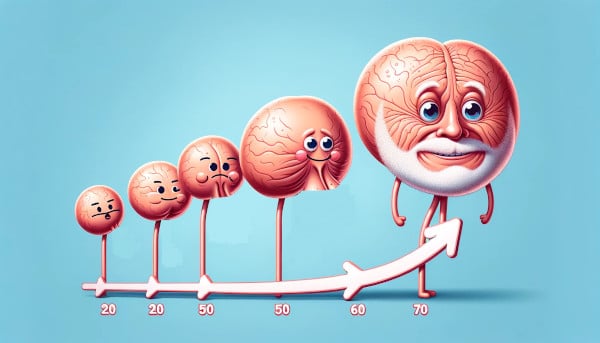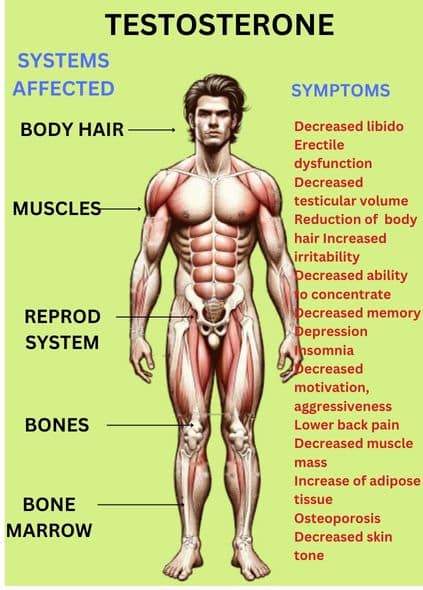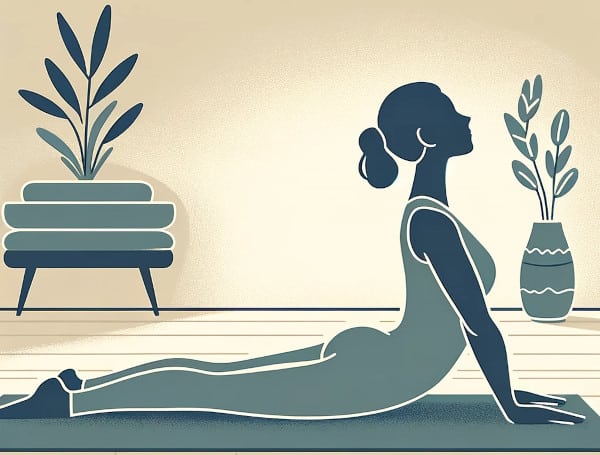Last Updated on July 7, 2024 by Max
Introduction
Have you ever heard of Milos of Croton? He’s not just a character from ancient Greek lore but a six-time Olympic champ with a training secret worth knowing. Picture this: Milos hoisting a calf daily, from its baby days to its full bull glory. Talk about commitment! This isn’t just a cool story; it’s the blueprint for progressive strength training, which, surprise, surprise, is fantastic for your prostate health and testosterone levels.
Contemporary research echoes this ancient wisdom, with studies revealing significant health benefits of regular exercise for men. The Harvard-based Health Professionals Follow-up Study found that more physically active men had a lower risk of suffering from BPH, with even low- to moderate-intensity activities like walking regularly at a moderate pace showing benefits (Harvard Health). Furthermore, vigorous physical activity has been linked to a 30% lower risk of developing advanced prostate cancer and a 25% lower risk of lethal prostate cancer (European Urology). In terms of hormonal health, exercise has been proposed to increase serum testosterone concentrations, demonstrating its crucial role in hormonal balance (NCBI).
In this post, we’re diving into the workout world inspired by Milos himself. We’ve got strength training, aerobic moves, and more, all tailored to boost your health and match your lifestyle. Ready for a journey that marries ancient wisdom with modern science? Let’s go!
The Science Behind Exercise, Prostate Health, and Testosterone
Understanding the Prostate and Testosterone Connection
The prostate, a small gland part of the male reproductive system, plays a pivotal role in men’s health. Its health is influenced by various factors, including lifestyle choices, with exercise being a significant one. As men age, their bodies undergo several changes, particularly in the reproductive system. Understanding these changes is crucial for maintaining health and well-being.

The prostate gland, a crucial component of the male reproductive system, also undergoes changes with age. Benign Prostatic Hyperplasia (BPH), a condition in which the prostate gland enlarges, is considered a progressive disease with age as its greatest risk factor. Histological evidence of BPH is found in about 8% of men aged 31 to 40, increasing to over 70% by the seventh decade of life. The average prostate weight reportedly increases from around 20 grams at age 40 to about 38.8 grams in men older than 80 years. As the prostate gland grows, it may squeeze the urethra, causing problems in passing urine, a condition more commonly noticed in men in their 50s and beyond.
Testosterone changes with age: Testosterone, the primary male hormone, is vital in various bodily functions. Typically, testosterone levels peak during adolescence and early adulthood. However, as men age, these levels gradually decline, usually about 1% a year after age 30 or 40. Most older men still have testosterone levels within the normal range, with only an estimated 10% to 25% having levels considered low. Additionally, the prevalence of biochemical testosterone deficiency increases with age, partly due to illness but also as a natural consequence of aging. There’s evidence of a steep decline in testosterone around age 30, with a possible rebound around age 50, after which levels remain roughly constant.

A study published in the “Journal of Clinical Endocrinology & Metabolism” highlighted that testosterone levels decrease with age, but lifestyle factors like obesity can accelerate this decline.
Dihydrotestosterone (DHT): DHT is a more potent derivative of testosterone. It’s crucial for developing male characteristics during puberty, but high levels in adulthood can contribute to prostate enlargement, known as benign prostatic hyperplasia (BPH). A study in “Prostate Cancer and Prostatic Diseases” noted the role of DHT in prostate growth, suggesting that managing DHT levels could be vital in preventing BPH.
Estradiol: This estrogen hormone, while typically associated with women, is also present in men and plays a role in regulating libido, erectile function, and even bone health. An imbalance, particularly an increase relative to testosterone, can be a concern for aging men. Research in the “Journal of Urology” found that higher estradiol levels relative to testosterone are associated with a greater risk of BPH and prostate cancer.
As men age, there’s a natural shift in these hormone levels. Testosterone levels gradually decrease, typically about 1% per year after age 30. Concurrently, there can be an increase in the conversion of testosterone to DHT and estradiol. This shift can lead to several issues, including a higher risk for BPH and possibly even prostate cancer.
The Role of Physical Exercise
Exercise plays a pivotal role in maintaining hormonal balance. Here’s how:
- Testosterone Boost: Regular exercise, especially strength training, can help maintain or even increase testosterone levels in older men.
- Weight Management: By helping to control weight, exercise indirectly influences hormone levels, as obesity is linked with lower testosterone and higher estradiol levels.
- Stress Reduction: Physical activity reduces stress and cortisol levels, which can otherwise negatively impact testosterone production.
Conclusion: The intricate dance of hormones like testosterone, DHT, and estradiol plays a crucial role in prostate health. Understanding these changes and how physical activity can help mitigate negative impacts is vital. Regular exercise, alongside a balanced diet and lifestyle adjustments, can significantly contribute to maintaining hormonal balance and overall prostate health.
Expert Opinions: The Role of Exercise in Promoting Prostate Health
Insights from June Chan, Sc.D., UCSF Research Team
June Chan, a prominent researcher at UCSF, has led multiple studies demonstrating the benefits of exercise in preventing or delaying prostate cancer progression. Her research indicates that aerobic exercise post-prostate cancer diagnosis may reduce the risk of recurrence or death by up to 60 percent. Chan’s earlier studies, funded by the Prostate Cancer Foundation (PCF), showed benefits from an hour of jogging six days a week. More recent studies suggest that even more achievable levels of exercise, such as walking 30 minutes a day or three hours a week at a brisk pace, can significantly lower the risk of prostate cancer recurrence.
Chan also highlights the various ways exercise benefits the body: it improves energy metabolism, lowers inflammation and oxidative stress, boosts immunity, and is beneficial for androgen signaling pathways. She underscores that exercise is good not just for the heart and lungs, but also for muscle strength and mass, burning fat, and reducing fatigue, anxiety, stress, and depression.
Importance of Strength Training: Strength training is particularly beneficial for men on androgen deprivation therapy (ADT) for advanced prostate cancer, who are at a higher risk of losing muscle mass, osteoporosis, weight gain, metabolic syndrome, and diabetes. Chan advises that if you have advanced prostate cancer, consult with your doctor to ensure strength training is safe and receive guidance on appropriate weights.
Starting Exercise Regimens: For individuals who haven’t exercised regularly, Chan suggests starting slow and consulting with a physician or personal trainer to get a program tailored to fit their needs. Starting with small increments and gradually increasing intensity is key to a successful exercise regimen.
Top Exercises for Prostate Health
Aerobic Exercises:

- Walking, Jogging, or Running: These simple yet effective activities boost cardiovascular health, which is indirectly beneficial for the prostate.
- Cycling: A great way to improve cardiovascular health, but it’s important to use a comfortable bike seat to reduce pressure on the prostate.
- Swimming: Offers a full-body workout with low impact on joints, making it ideal for all ages.
Strength Training
- Squats and Lunges: These exercises strengthen the lower body and core, which can improve pelvic floor health.
- Leg Presses: Good for building lower body strength without putting too much strain on the back.
Yoga and Pilates

- Gentle Yoga Poses: Poses like the Child’s Pose, Cobra, and Warrior can help in maintaining flexibility and reducing stress.
- Pilates: Focuses on the core, including pelvic floor muscles, enhancing overall stability and strength.
Low-Impact Sports

- Tennis or Badminton: These sports offer a fun way to get aerobic exercise and improve agility and coordination.
Pelvic Floor Exercises
Kegels: Specifically target the muscles of the pelvic floor, which can help in managing symptoms of prostate enlargement.
Kegel exercises, named after Dr. Arnold Kegel who first described them, are simple contractions of the pelvic floor muscles. They’re often recommended for improving prostate health and urinary continence. Here’s how to perform them:
Identify Pelvic Floor Muscles: These are the muscles you use to stop urinating mid-stream or prevent passing gas. Contract and Relax: Tighten these muscles, hold the contraction for three to five seconds, and then relax for three to five seconds. Aim for at least 10-15 repetitions per session, three times a day. Breathe freely during the exercises; don’t hold your breath. Do these exercises regularly for the best results.
Kegel exercises can be done discreetly, almost anywhere, and at any time, making them a convenient and effective way to strengthen the pelvic floor muscles.
Visualizing the muscles contracted during Kegel exercises can be helpful in understanding and performing them correctly. These muscles stretch like a hammock from the tailbone at the back to the pubic bone in front. When you perform a Kegel exercise, you’re contracting and lifting these muscles, similar to trying to stop the flow of urine or prevent passing gas.
Here’s a simple illustration:
- Imagine sitting on a marble. The muscles you would use to lift and hold that marble are your pelvic floor muscles.
- When you contract these muscles during a Kegel exercise, visualize them lifting upwards inside your pelvis.
- As you relax, imagine these muscles gently releasing and lowering back down.
This mental visualization can aid in ensuring you’re engaging the correct muscles and performing the exercise effectively.
Safety of Kegel Exercises
Kegel exercises are generally safe, but there are some situations where caution is advised:
- Overuse: Overdoing Kegel exercises can lead to straining the muscles, causing more harm than good.
- Incorrect Technique: Performing Kegels incorrectly, like contracting the abdominal, buttock, or inner thigh muscles, can lead to ineffective results and other complications.
- Pre-existing Conditions or Surgery: Individuals with certain medical conditions, such as surgery or active urinary tract infections, should consult with a healthcare professional before starting Kegel exercises.
- Individuals with active hemorrhoids should exercise caution when performing Kegel exercises. Straining or overuse of pelvic floor muscles during Kegels can exacerbate hemorrhoid symptoms. It’s important to do Kegels gently to avoid increasing pressure in the anal region. If Kegel exercises cause discomfort or worsen hemorrhoid symptoms, it’s advisable to stop and consult a healthcare professional.
Exercises to Naturally Balance Testosterone Levels

Exercises known to help balance testosterone levels typically involve a combination of strength training and high-intensity interval training (HIIT):
- Strength Training: Lifting weights and resistance training are effective in boosting testosterone. Focus on compound movements like squats, deadlifts, bench presses, and rows, which work for multiple muscle groups.
- High-Intensity Interval Training (HIIT): Short bursts of intense activity followed by rest periods. Examples include sprinting, cycling, or circuit training. HIIT has been shown to significantly increase testosterone levels.
- Restorative Exercises: Activities like yoga and Pilates, while not as directly linked to testosterone production, can help reduce stress and cortisol levels, indirectly supporting hormonal balance.
- Outdoor Activities: Exercises like hiking or outdoor sports can be beneficial, partly due to sunlight exposure which aids in Vitamin D production, a vitamin linked to testosterone levels.
Incorporating a mix of these routines into your weekly exercise plan can help in naturally balancing testosterone levels. It’s important to have a well-rounded exercise regimen and to avoid overtraining, as excessive exercise can negatively impact hormone levels.
Safety Tips and Considerations
If you’re new to exercise, begin with low-intensity activities and gradually increase intensity. Learn the correct form for each exercise, preferably under the guidance of a trained professional, to prevent injury. Pay attention to your body’s signals. Discomfort is normal, but pain is a warning sign to stop and reassess. Drink plenty of water before, during, and after exercise.
When to Consult a Doctor: Individuals with pre-existing health issues, particularly related to the heart, lungs, or prostate, should consult a doctor before starting a new exercise routine. If you’ve recently had surgery, especially in the pelvic area, or are undergoing treatment for prostate-related issues, seek medical advice before exercising. Consult a healthcare professional if you experience unusual symptoms like severe pain, dizziness, or shortness of breath during or after exercise.
Remember, the goal is to improve health, not to push beyond safe limits. Professional guidance is crucial in tailoring an exercise routine that’s both effective and safe for your specific health circumstances.
Conclusion
In the journey toward optimal health, it’s crucial to embrace a holistic approach. Men’s health, especially concerning prostate health and testosterone balance, benefits significantly from a combination of regular exercise, proper nutrition, stress management, and regular medical check-ups. Begin by integrating the exercises discussed into your routine, tailored to your fitness level and health needs. Remember, it’s not just about a single aspect of health but about nurturing your body and mind as a whole.
Start today, and take a decisive step towards a healthier, more balanced life.
We’d love to hear from you! Share your experiences or tips in the comments below. Have these exercises worked for you? Do you have any personal insights or stories about improving prostate health and testosterone balance? Your contribution could be invaluable to someone else on their health journey. Also, don’t forget to share this post on social media! Tag your friends or family members who might find this information helpful. Together, we can build a community focused on health, wellness, and mutual support.
References
- Travison, T. G., et al. “Population-Level Decline in Serum Testosterone Levels in American Men.” The Journal of Clinical Endocrinology & Metabolism.
- “The association between testosterone, estradiol and their ratio and mortality among US men.” PubMed.
- Carson, C. III, et al. “The role of dihydrotestosterone in benign prostatic hyperplasia.” PubMed.
- “3 ways exercise helps the prostate (yes, the prostate)” – Harvard Health.
- “Long-term vigorous exercise may lower risk of advanced and fatal prostate cancer” – European Urology.
- “Various Factors May Modulate the Effect of Exercise on Testosterone” – NCBI.
- Prostate Cancer Foundation – Exercise is the Turbo Boost to a Healthy Prostate:
- June Chan, Sc.D., UCSF Research Team’s studies on exercise and prostate cancer.
- Benefits of aerobic exercise and strength training for prostate health.
- 1MD Nutrition – 5 Important Exercises To Help Maintain Prostate Health:
- General recommendations for exercises supporting prostate health, including aerobic exercises and yoga.

Hey Max! 🏋️♂️ This post is a treasure trove of wisdom on prostate health and testosterone. Milos of Croton’s calf-lifting dedication is truly inspiring. 💪 The connection between exercise, hormones, and prostate health is fascinating. I’m curious, though—what specific exercises do you personally find most effective for maintaining your prostate health? Also, love the expert insights from June Chan! Do you have any future posts planned on incorporating these exercises into daily routines? Excited to hear more!
Hi Hanna,
Thank you for your feedback on the post! Regarding your question about the specific exercises I find most effective for prostate health, I’ve personally experienced great benefits from a mix of cardiovascular exercises like brisk walking or jogging, along with strength training exercises that engage the core. These activities not only help in maintaining overall physical fitness but also seem to have a positive impact on prostate health and testosterone levels.
Thanks again for your interest and support!
Best,
Max
Hi Max, this is a fantastic blog post! Your article on boosting prostate health and testosterone through targeted exercises is an excellent resource for men seeking a proactive approach to their overall well-being. I’m glad to hear that I’ve been doing everything in this article, however, I do wonder how much is too much? I train as a badminton athlete hoping to go pro one day which requires me to train six times a week for approximately 5-6 hours a day. Could that potentially reduce my testosterone levels?
Hi Kevin,
Thank you for your kind words and for sharing your training routine. It’s impressive to hear about your dedication to badminton. Regarding your question, while regular exercise is helpful for testosterone levels and prostate health, there is a point where too much training can have the opposite effect. Intense training, especially those involving long hours and high frequency like yours, can lead to increased stress and fatigue, potentially reducing testosterone levels. This is often referred to as overtraining syndrome.
It’s crucial to balance intense training with adequate rest, nutrition, and stress management to maintain optimal hormone levels and overall health.
Keep up your passion for badminton, but consider balancing your training regime.
Best regards,
Makhsud